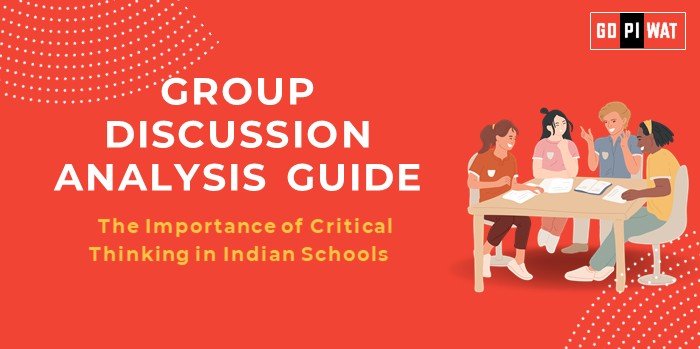📋 The Importance of Critical Thinking in Indian Schools
🌐 Group Discussion (GD) Analysis Guide
💡 Introduction to Critical Thinking in Indian Schools
Opening Context: “Critical thinking is the cornerstone of a robust education system, enabling students to evaluate information, solve problems, and make informed decisions—a skillset crucial for India’s next generation of leaders.”
Topic Background: Historically, Indian schools have emphasized rote learning due to standardized testing and a focus on memorization. However, the rapidly evolving global landscape demands a shift toward fostering critical thinking to prepare students for real-world challenges.
📊 Quick Facts and Key Statistics
- 🏫 Education System Size: India has over 1.5 million schools and 250 million students, emphasizing the scale of implementing reforms.
- 🌍 Global Rankings: India ranks 74th in the 2022 Global Talent Competitiveness Index, reflecting the need for critical thinking development.
- 📈 21st Century Skills Demand: “70% of jobs in 2030 will require critical thinking, creativity, and problem-solving” (World Economic Forum, 2023).
- 📜 Policy Push: The National Education Policy (NEP) 2020 explicitly advocates for experiential and analytical learning.
🤝 Stakeholders and Their Roles
- 🏛️ Government: Drives reforms through policies like NEP 2020 and teacher training programs.
- 🏫 Schools and Teachers: Act as frontline implementers through pedagogy and innovative classroom practices.
- 👨👩👧 Parents and Students: Advocates for prioritizing analytical skills over rote learning.
- 💻 EdTech Companies: Provide tools and platforms to enable interactive, analytical learning experiences (e.g., Byju’s, Khan Academy).
🏆 Achievements and ⚠️ Challenges
✨ Achievements:
- 📜 Policy Framework: NEP 2020 mandates critical thinking and experiential learning.
- 🚀 EdTech Growth: Platforms like Byju’s and Khan Academy promote analytical learning and student engagement.
- 🌟 Case Example: Delhi’s government schools implemented project-based learning initiatives, fostering creativity and critical thought.
⚠️ Challenges:
- 👩🏫 Teacher Training Gaps: Only 40% of teachers report familiarity with modern pedagogical practices.
- 🏫 Resource Gaps: Rural schools face challenges such as lack of infrastructure and trained educators.
- 🛠️ Mindset Shift: Resistance to transitioning from rote learning to analytical approaches persists in many schools.
Global Comparisons:
- 🇫🇮 Finland: Emphasizes critical thinking in its curriculum, ranking high on global education indices.
- 🇸🇬 Singapore: Focuses on skills-based learning with a problem-solving orientation, producing globally competitive graduates.
Case Study:
🌟 Delhi Model: Experiential learning programs such as “happiness classes” and practical modules have successfully promoted student engagement and critical thinking skills.
🗣️ Structured Arguments for Discussion
- Supporting Stance: “Introducing critical thinking in schools will equip students with problem-solving skills, essential for a dynamic job market.”
- Opposing Stance: “Without addressing resource and training gaps, introducing critical thinking could widen inequalities.”
- Balanced Perspective: “Critical thinking is essential, but its success depends on comprehensive teacher training and equitable access to resources.”
💬 Effective Discussion Approaches
🔹 Opening Approaches:
- 💬 Quote: “Education is not the learning of facts but the training of the mind to think—Albert Einstein.”
- 📊 Data-Driven: “70% of future jobs will require critical thinking, yet Indian schools largely emphasize rote memorization.”
🔄 Counter-Argument Handling:
- ⚖️ Acknowledge implementation barriers but propose solutions like phased integration and public-private partnerships.
- 🌍 Use global examples to show successful implementation of critical thinking-focused education systems.
📊 Strategic Analysis of Strengths and Weaknesses
- 💪 Strengths: NEP 2020 framework, growing adoption of EdTech platforms.
- 🔻 Weaknesses: Resource disparities, limited teacher training, traditional pedagogical mindsets.
- 🚀 Opportunities: Leveraging AI for personalized learning, global collaborations for curriculum design.
- ⚠️ Threats: Digital divide and resistance to change from educators and policymakers.
📚 Connecting with B-School Applications
- 💼 Real-World Applications: Linking leadership skills to analytical thinking and problem-solving abilities.
- 📊 Research Areas: Policies that bridge urban-rural educational divides.
- 🔍 Sample Interview Questions:
- 💬 “How can critical thinking improve India’s education system?”
- 🌍 “What role do EdTech companies play in fostering analytical learning in classrooms?”
- 💡 Insights for Students:
- 🌟 Explore internships in educational policy-making and EdTech innovation.
- 🚀 Study models like Finland’s and Singapore’s education systems to identify scalable solutions for India.


